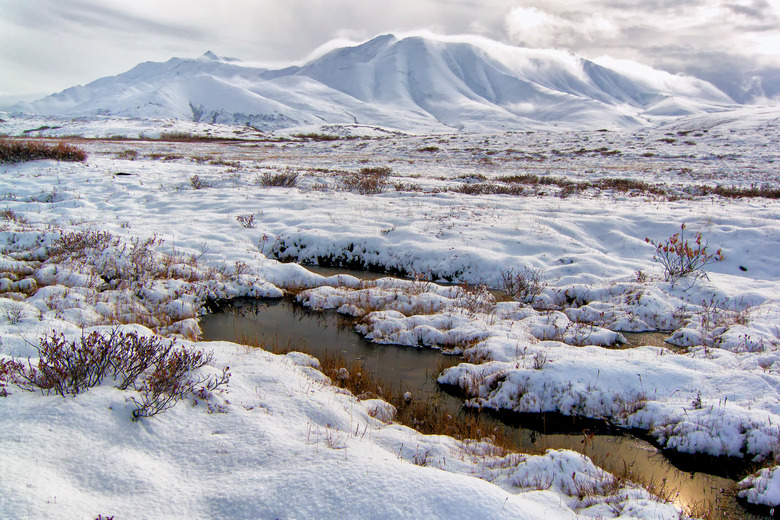Fast Facts On Biomes In The Tundra
Biomes are a collection of similar ecosystems. Biomes can be defined by the community of plants and organisms that live in them.
Examples of different biomes include desert, tundra, forest, grassland, freshwater and marine.
Tundra Definition
Tundra Definition
Although the tundra is considered a harsh and sparse landscape, life still exists there. Tundra habitats are extremely cold with low biodiversity.
Trees are unable to grow here due to the ground being permanently frozen. A short growing and reproductive season often result in oscillating population dynamics.
Tundra Locations on Earth
Tundra Locations on Earth
The tundra biomes can be divided into two sections, the Arctic and the Alpine. The Arctic tundra encircles the North Pole, extending down to the taiga where the coniferous forests begin. Antarctica contains some areas that could be considered tundras, but because it is a lot colder and never thaws, it is not classed as a tundra.
Alpine tundras are located around the world high in the mountains where trees cannot grow. Alpine tundras tend to begin around 11,000 to 11,500 feet (3,350 to 3,500 meters) above sea level. If the area is highly exposed to winds, this boundary may be at a lower altitude.
Tundra Biome Facts
Tundra Biome Facts
**The Arctic tundra covers about 20 percent of the Earth's surface.** The word "tundra" is derived from the Finnish word for barren land, tunturi. The Arctic tundra is also called the land of the midnight sun due to the sun shining 24 hours a day in summer. The average annual temperature in the Arctic tundra is minus 18 degrees F (minus 28 degrees C) with lows of minus 94 F (minus 70 C) in the middle of winter.
The Alpine tundra differs from the Arctic tundra in that the soil is well-drained. Growing seasons also tend to be longer in most places, reaching up to 180 days. Alpine tundra temperatures reach below zero overnight. During the day Alpine temperatures often range from 50 to 59 F (10 to 15 C).
In tundra biomes, precipitation including snow melts is between 5.9 to 9.8 inches (150 to 250 millimeters) a year. NASA describes deserts as places with usually less than 11.8 inches (300 millimeters) of rain a year. This means that despite all the snow, tundras are drier than many deserts around the world.
Animals in the Tundra
Animals in the Tundra
The few tundra animals that are capable of living in this harsh environment have adaptations such as fur and feathers that keep them warm.
One of the most famous Arctic tundra animals is the polar bear, which is one of the top predators in this environment. Arctic foxes, hares and musk ox are common tundra mammals. Animals like caribou and the semipalmated plover migrate to warmer grounds when cold temperatures peak.
Birds are also adapted to the tundra environment, such as the rock ptarmigan and snowy owl. Because reptiles and amphibians rely on the environment to regulate their body temperature, they are not suited to living in tundras.
Parasites can also be found in the tundra and often use the body heat of their hosts to buffer themselves from the extreme cold.
Plants in the Tundra
Plants in the Tundra
While trees cannot grow in the tundra, it still has an abundance of plants that have adapted to the cold climates. There are around 1,700 recorded species of Arctic plants, including small flowering plants, dwarf shrubs, herbs, grasses and mosses. Lichens and fungi, while not in the plant family, are also important species in tundra biomes.
Plants that are capable of living in tundras tend to be small and low to the ground. Shallow root systems allow them to survive in the thin layers of soil. Some plants like the pasqueflower (Pulsatilla) have tiny, silky insulating hairs to help keep them warm. Plants blossom in the six- to 10-week Arctic growing periods when the permafrost snows melt.
References
- Blue Planet Biomes: Tundra Biomes
- University of California Museum of Paleontology: The Tundra Biome Online Exhibit
- University of California Museum of Paleontology: The Tundra Biome
- The Ohio State University: Life in the Tundra
- National Parks Service: Alpine Tundra Ecosystem
- NASA Earth Observatory: Tundra
- Nature Climate Change: Climate Sensitivity of Shrub Growth Across the Tundra Biome
- New Hampshire PBS: Tundra
- The Animal Spot: Tundra Animals
- The Ohio State University: Plants of the Arctic and Antarctic
- National Geographic: Biome
- NASA Earth Observatory: Desert
- Blue Planet Biomes: Alpine Biome
Cite This Article
MLA
Jerrett, Adrianne. "Fast Facts On Biomes In The Tundra" sciencing.com, https://www.sciencing.com/fast-biomes-tundra-7741621/. 22 November 2019.
APA
Jerrett, Adrianne. (2019, November 22). Fast Facts On Biomes In The Tundra. sciencing.com. Retrieved from https://www.sciencing.com/fast-biomes-tundra-7741621/
Chicago
Jerrett, Adrianne. Fast Facts On Biomes In The Tundra last modified March 24, 2022. https://www.sciencing.com/fast-biomes-tundra-7741621/
